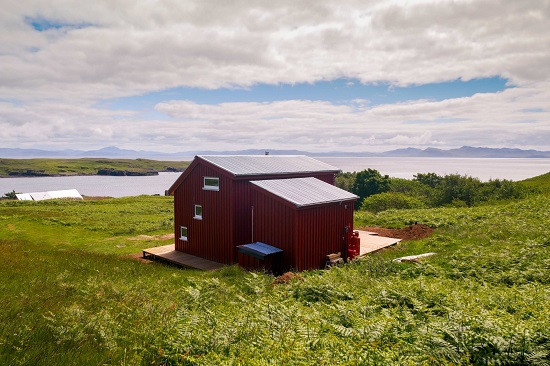St. Franny’s Bothy on The Isle of Eigg
The Isle of Eigg lies about ten miles from Scotland’s west coast. Of roughly one hundred inhabitants, Johnny Lynch, who records and performs under the name Pictish Trail, is one of the most remarkable. He first visited in April 2010, and found himself “instantly taken by the place, the people, the air. The dolphins, showing off.” Within a month, he’d plotted a festival. “My excitement must have been contagious, as it sold out within five minutes of going on sale,” he recalls. “The event happened in September of that year, and the island has been my home ever since. I couldn’t leave, it’s an incredible community.”
During that festival – called ‘Howlin’ Fling!’ – many of the artists he invited over to play were similarly captivated by Eigg’s dramatic landscapes and potent creative spirit, enthusing as much to their host. “That got the brain ticking,” he continues. “I started to formulate a plan, putting together a rough idea of what it would cost to start a residency programme; getting the artists here, accommodating them, feeding them, paying them; what equipment I’d need to provide; how to distribute the music they’d make; ideas about it being a subscription service, something where people were signing up to the concept as opposed to individual acts; documenting the whole thing with a podcast.”
After years of seeking funding, “filling in endless forms, actually ticking all those endless boxes, all that bollocks,” Lynch decided to initiate the project, which he named Visitations, himself. In 2017 he invited his friend John B. McKenna of Monoganon to Eigg, to be the first to spend a week in residency on the island. The results would be recorded and then released via Lynch’s label Lost Map. “I thought, ‘fuck it, I’m gonna provide my own half-broken instruments and fucked gear, he’s gonna make some sort of music, and we’re going to put it out on Lost Map. We’ll see if folks like the whole thing, and we’ll take it from there. If nothing ese, I’ll be able to see my pal. About two weeks before John arrived, we got the funding to support the entire first series. Ha. I bought a nice new synthesiser, immediately.”
Inspired by subscription-based imprints and singles clubs run by labels like Twisted Nerve and Regal, the plan was initially to get each artist to come away from Eigg with a double A-side seven inch release, potentially using the same set of instruments each time, but once Monoganon started work on what would become a sprawling and multi-faceted 40-minute epic, “I realised pretty quickly that it was pointless to impose restrictions on creativity. I was more interested in what folks would come up with when left to (and with) their own devices.”
A residency by Free Love – the duo formerly known as Happy Meals’ first work under their new name – followed, and then another by Neil Hamilton Wilkinson and Abi Fry of British Sea Power with their project Slow Tree, who also produced a 44-minute film to accompany their musical work. Their work was made available to subscribers on vinyl, with Lynch also recording a podcast with each to help contextualise their work. Lost Map’s in-house designer David Galletly oversaw sleeves, online content, layouts and logos, ensuring a consistent visual identity. In November 2018, all three were released as a digital album, concluding ‘series one’ of the Visitations series.
What those first three EPs made apparent was just how much Eigg, just five by three miles in surface area, has the atmospheric potency to inspire thousands of completely unique pieces of art. Lynch continues, “I guess I had hopes that some of the artists would incorporate field recordings of the island within their music, and almost all of them have done that, and I like the idea of each record in the series being a sort of time capsule, of life on Eigg. Other than that, I don’t know if I had any specific expectations, but I deliberately chose acts that I felt would each approach the project in a different way. What’s been particularly cool is to see is each release being a starting point of sorts for the acts involved – music they’ve been compelled to make, not forced to. Having spoken with all the artists for the podcast, I know that none of them came with any specific expectations as to what they would create, and I’ve tried to approach curating the series with that same sense of openness.”
For the second series of records, which is currently ongoing, Galletly is now working with Glasgow-based artist Caio Wheelhouse for the artwork, while artists now record in the newly renovated St. Franny’s Bothan, operated as a BnB by Lynch’s partner Sarah. True to the form that first run established, the 2020 run has so far seen two very different EPs. The first is by Arthur King, a constantly evolving collective of filmmakers and musicians who for their trip to Eigg were bolstered by the addition of their friend Jason Lytle of Grandaddy. The group’s best-known work is their ‘Changing Landscapes’ series, in which they spend time in a specific location, filming and taking field recordings which they then use for a climactic audiovisual performance in the same location. Lytle had arranged his Visitations residency to conclude a run of British and Irish shows, and given Arthur King’s prior projects they seemed the perfect friends to bring along with him.
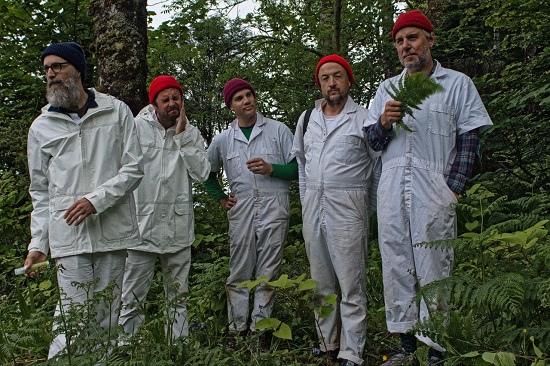
Arthur King, photo by Stephanie Gibson
He describes the group’s daily routine: “Wake up in the Bothy, wonder where I am, drink a lethal amount coffee, put on my smurf-like outfit” – he refers to the group’s matching get-up of white overalls and bright red woollen hats – “and head out either on foot or by rented bike.” In groups they covered as much of the island as they could, taking pictures, films and sound recordings as they wandered its rugged cliffs, meandering meadows and beautiful beaches until the evening, whereupon they’d head twenty minutes down the hill to the local pub. Their EP, which you can hear samples of below, sounds sprawling and teeming with the life of the island, voices and the bleats of sheep. “I really love places that are more wild than modernised or overly cultivated,” Lytle continues. “I feel more alive and in touch with my environment. I’m not a chaotic, bustling city person. I was feeling like I was immersed in a somewhat wild and only slightly tamed place while I was there, which I liked a lot.”
The work produced by London-born, now Glasgow-based Rachel Aggs, meanwhile, is completely different. Where Arthur King’s occupation of St. Franny’s saw it cluttered and chaotic, Aggs saw the Visitations residency as a rare chance to work completely solo after years spent in bands like Shopping, Trash Kit and Sacred Paws. Bringing along a guitar, a cheap drum machine and a fiddle to record with, her EP is less redolent of Eigg’s vibrant atmosphere but better reflects the isolation and intimacy of the Bothy itself, where massive windows offer sweeping views of the coastline, through which the rising sun would calmly wake her every morning. “It’s a very calm space,” she recalls. “I was kind of worried it would be really, really intense but it wasn’t. Johnny’s house is just down the hill, so that was reassuring, and there was a pub and the village shop a 20 minute walk away, so it’s not really that remote, but if you’re used to living in a flat in Glasgow…”
On the podcast produced by Lost Map to accompany the release, she compares her time there more to the joy of live gigs than the pressure and relentless self-analysis of a week’s studio time. “I think it’s difficult to put my finger on it,” she expands to tQ, “but I think that because I was so isolated I was able to regress a bit and, in a childlike way, just play around and be in the moment. I knew that Johnny would put out whatever it was I was made so there was a slight pressure, but I also quickly realised I was having so much fun just making the stuff. Sometimes I’ll make something, and I’ll really love playing it for about an hour and then I’ll just start hating it. I realised that if I was going to get through this week and enjoy it while also having something to show for it, I just had to keep moving on. I got into a rhythm that was just super fun, I was never in the negative critiquing zone, I was always in this place of responding and creating.”
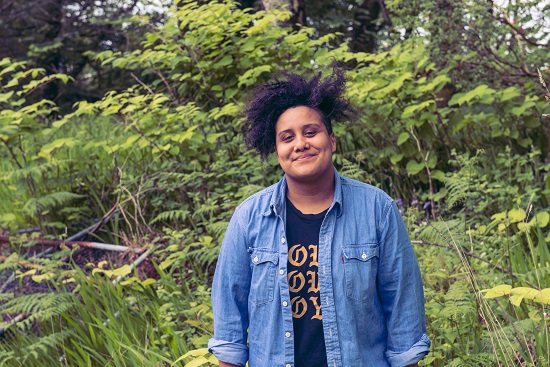
Rachel Aggs, photo by Stephanie Gibson
Though Aggs had vague ideas of recording some ambient or experimental work, by the time her week was up she had produced a series of sublime, self-contained songs. Lynch, who is never less than effervescent when asked to review a Visitations release, calls them “what I secretly hoped Rachel would do – lots of songs unselfconsciously capturing as many ideas as possible. It’s an intimate audio diary of thoughts and feelings from a week spent in isolation. There’s a lot of hope in there, songs about self-motivation, embracing a sense of escapism, but also songs that search inwards, and express a deep longing for company. Given the recent lockdown situation, they feel particularly resonant now. I’m a huge fan of Rachel’s music, I really love the boundless energy in her songs, voice and guitar work – and it’s all over this album she’s made.”
Both Aggs and Lytle at times found similar sources of inspiration, such as the island’s striking coastline. “The drama of the sea and how it shapes the place is something I didn’t quite factor in and enjoyed a lot,” says the latter when he recounts what he was anticipating before the trip to Eigg. One of the most touching moments on the former’s EP is sequence recorded outdoors on violin, improvised as she stood on a hill and took in a plunging view of the water below.
Nevertheless, in terms of sound Aggs and Lytle’s EPs could not be more different. By extension, everything the Visitations series has produced so far offer wildly different views of the exact same place. It’s no surprise that everyone who works in St. Franny’s seems to set up in the exact same spot, in front of that great big window. “It’s like you look out at this amazing view and you’re directly responding to it, like a landscape painter but with your instruments instead of a canvas,” says Aggs.
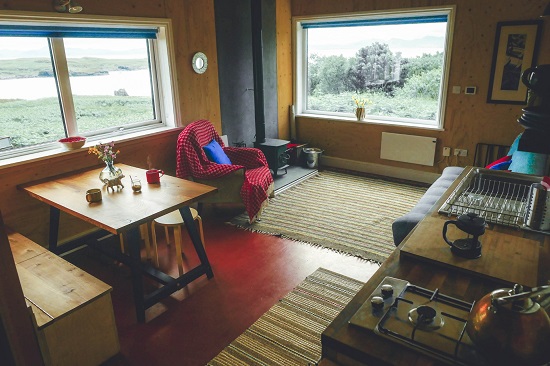
St. Franny’s Bothy
Where Aggs embraced the solitude of the Bothy, Lytle and Arthur King spent much of their time among the island’s small community. “I appreciated the straight talking, a little rougher-around-the-edges vibe of the locals I picked up on,” Lytle recalls. “It reminded me of some of my preferred and closer friends back home…” One day, they met another of the most genial islanders in Ailidh Morrison, who as well as being Eigg’s resident poet who was running her weekly kitchen in the community hall. “The guys in my group, being way better than I am at meeting people, befriended her immediately, presumably winning her over by insisting on doing the dishes in the kitchen for her after her shift.” With the traditional conclusion of one of Arthur King’s ‘Changing Landscapes’ projects being an audio-visual live gig, when the group were short of a venue Morrison “ended up offering her place up for us, removing all of her living room furniture,” Lytle continues. “She’s also a real good cook, making up a bunch of amazing food while we played at her house. I was captivated by her continuous storytelling, despite only understanding about 45% of what she was saying.”
Lynch witnessed the show they played there. He describes it as “Cosmic. They took over her entire place, filling it with loads of equipment. It took a long time for them to set up, and they jammed for what seemed like hours in her living room – the musicians Jason, Aaron Espinoza and Peter Walker each playing samplers, synths, drum machines, and guitar. Their friend John Schlue was creating a video collage of footage he’d collected of the island over the week and editing it in real time in response to the music. It was pretty psychedelic. This collage was then being fed to a projector outside of the cottage, and projected on to the walls – and this, in turn, was being filmed by another member of the Arthur King crew, Aaron Farley. Watching them perform, interacting with one another, and reflecting their sonic and visual interpretation of Eigg back on to the island (quite literally) was unlike any musical experience I’d had before. The project is called ‘visitations’, and it really did feel like Arthur King had landed on our alien planet, dressed in their matching white spacesuits, and had attempted to communicate with us.”
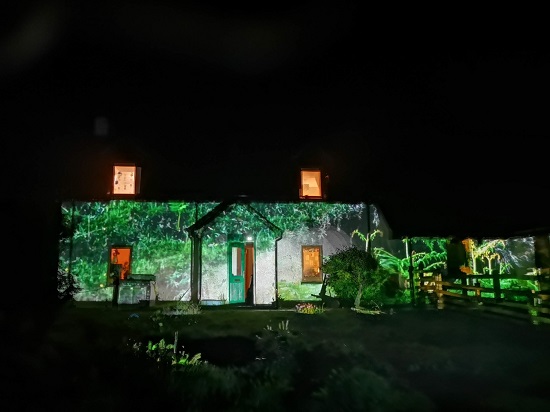
Arthur King’s show, projected onto Ailidh Morrison’s cottage
The next day was that year’s instalment of Howlin’ Fling! festival. Lytle played a solo set during the day, and at 3.30 in the morning Arthur King played again. “It was bright sunshine when they stopped,” remembers Lynch. “Everyone in the audience was out of their tree. It was pretty surreal. I believe the final track of their record, ‘St Franny’s’, was taken from this festival performance. I really loved it, was so cool having it be part of the event. If I’d been more prepared, I’d have had everyone in the audience dress up as aliens.”
“I was just delirious and exhausted,” says Lytle. “Apparently most everyone who remained upright and awake was on some kind of mind-altering substance, which is fine I suppose because whatever it was caused them to dance and weave around and seem enthused. People were extremely gracious. I plan on returning, I hope.”
Howlin’ Fling! is ostensibly separate from the Visitations series, but both have now become respective parts of Eigg’s particularly rich cultural tapestry, and therefore a part of one another; it’s perhaps no surprise that one of the reasons Aggs was so keen to take part in Visitations was the sets she’d played there both with Trash Kit and Sacred Paws. There is a certain spirit with its source in the Isle of Eigg itself that is given the space to manifest by the artists and creatives who surround both projects, wonderful in every one of its infinite guises.
Series two of the Visitations series is currently ongoing, with physical and digital subscriptions available now. To sign up, hear Lynch’s podcasts and for more information, click here. The next Visitations release will be by Rozi Plain and released in October.

